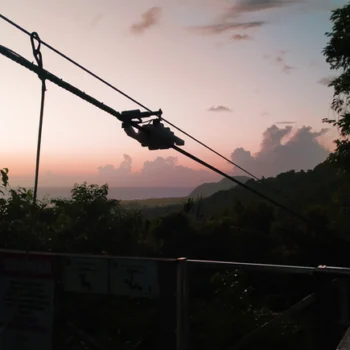
Zip Line Building: 7 Phases to Building a Zip Line
The construction of a zip line is a lot more complicated than many realize. Backyard zip lines are plain dangerous if they have not gone through the design process by a professional zip line builder. The available standard zip line kit that you can buy on the internet is not necessarily the best option for a safe flying experience. Many factors need to be taken into account when building a zip line. The precise mathematical calculations that are done to ensure rider’s safety can be the difference between lots of fun and an accident. Here at Skyline zip lines, it’s our job to ensure maximum safety and the best experience. To create the premium zip line product we guarantee, we use a 7 step process to ensure success.
Site Discovery
Skylines site discovery is the first step into zip line building. A site discovery ensures a zip line site will be a feasible, profitable, and safe operation. Trained professionals must visit the proposed zip line site to complete a walk-through of the whole project to plan potential take-off zones, landing zones, and anchor points to ensure the correct slope angle is available to make a feasible zip line. In addition to the physical aspect of the location, there needs to be a human geography analysis to ensure the venture will be profitable. The consideration of the zipline site’s current visitation numbers, visitor demographics, and nearby urban markets is a requirement when building a new zip line.
Site Design
Once the site discovery is complete, site design commences. The site design is the beginning of the zip line development and the creation of a business plan for the attraction. During the zip line design, the use of schematic drawings to identify and finalize the zip line corridors, potential obstructions, and functional topographical factors, ensures the best zip line possible. In addition, the products and supplies required to build the zip line are determined to finalize equipment such as harnesses, catchers, cables, and braking systems are all included. In addition to the physical zip line, the business plan is finalized and perfected with profit margins, goals, desired throughput rates, and the construction budget. After completion of these two processes in the site design phase, it is time to move on to the engineering of the zip line.
Zip Line Engineering
Zip line engineering is crucial to the zip line building process. The engineering of a zip line ensures the zip line is safe, functional, reliable, and follows all Z98 Ropeway, CSA, and TSSA standards. The engineering required ensures adherence to the safest practices meaning, no cable around the trees or bungee braking systems, and the correct cable tension, cable length, cable sag, and anchor points are in place. In addition, Skyline’s technicians run a technical feasibility study checking:
- Structural force analysis
- Rider velocities and kinetic forces
- Studies on crosswinds, tailwinds, and headwinds
- Cable specifications, tensions, and safety margins
- Secondary dampening and braking calculations
- Recommended trolleys, catch blocks, and harnesses
- Site-Specific operations and maintenance manuals
- Throughput analysis
From the technical feasibility study, the zip line starts to come together, and the start of construction is nearing.
Fabrication of Parts
The design and engineering of all Skyline’s zip line equipment and structures are complete in Canada and the USA to ensure the highest quality possible. All zip line equipment from trolleys, catchers, and launchers are made in-house at Skylines machine shop in Canada. The towers, platforms, and structures are designed and engineered in Canada, fabricated locally (if possible), and assembled on site. This ensures the most cost-effective zip line building experience available.
Construction and Installation
After the intensive process of site discovery, design, engineering, equipment selection, and structure fabrication, it is finally time to build the zip line. The zip line construction process is a crucial step to the zip line project. Safety is of the highest priority. Everyone on site must be using the safest practices possible and abiding by all safety protocols. In addition, a timeline and project management is crucial to the success of the zip line structures and zip line installation. Last, but not least, is the mindfulness of the natural landscape of the zip line site. Zipline operators should aspire to leave as much natural landscape untouched as possible to give the best canopy tour experience and preserve nature, blending the zip line attraction into the natural environment.
Training Support and Operations
Now that the zipline is standing, it is time to learn the in’s and out’s of the operation, train staff, and go over operating safety protocols. The whole experience up until this point has ensured the line terminates in the right places, vertical drop per 100 meters is correct, and the operation will run well. The new attraction that has been a long time coming is finally available for the public to have an experience of a lifetime.
Safety Inspections
After the attraction begins to operate, safety inspections are crucial to the overall safety of guests and staff alike. Yearly site inspections are mandatory to ensure every aspect of the zipline is in working order and abides by the most up-to-date safety protocols to ensure no fatalities, injuries, or lawsuits occur. Maintaining the highest safety standards is mandatory to continue zip line operations.
- Posted by admin
- On February 9, 2022






